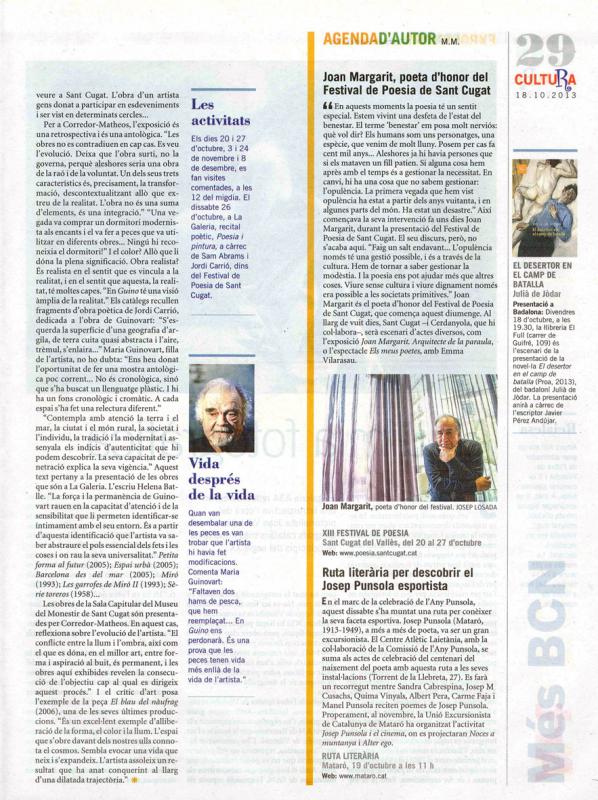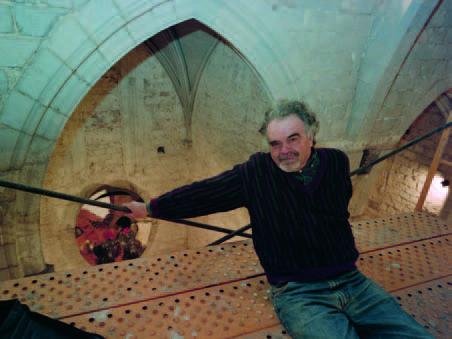Guinovart
Josep Guinovart.
La GaLeRia,Sant Cugat
Undoubtedly, the media technology society has made a large amount of information available to the majority. We believe that we can access any knowledge with a couple of clicks of the computer and we participate in a vertiginous dynamic that pushes our attention from one reason to another, without giving us time to digest the bombardment of stimuli to which We are constantly submerged.
Given the lack of time, the viewer hopes to look at him, explaining the meaning of artistic production. The artists are expecting grandiose gestures that conquer the media scene where the fleeting triumphs are measured. There are attempts to approach people's humanity, to the original, but the anecdote is often confused with what is important and wasting time with what is superficial.
We need to find spaces where we can really find ourselves and be able to understand our site in relation to the environment. The production of Guinovart, from which we now present a sample that covers work from the year 1956 until his death in 2007, rises as a watchtower from where the artist gives us this opportunity while doing -Who are part-time participants. Carefully contemplate the land and the sea, the city and the rural world, society and the individual, tradition and modernity and points to the indications of authenticity that we can discover. Its capacity for penetration explains its validity, now even more significant when six years have elapsed since its death. We just have to calm down the rhythm and be prepared to enter, as the artist did when he undertook each work, in the matter and the fundamental gesture that gave him an environment and specific circumstances.
Guinovart's years of training follow a pattern that we find in other Catalan artists of the time: moving from the city to the countryside during the civil war, studying at Lonja while working in the family business the first years of the postwar period, attending classes At the FAD, he became a member of Cercle Maillol, he received a scholarship from the French Institute to study in Paris (1953), he stays in various places in Europe, visits Picasso, etc. In the 1940s, his painting evolved into a schematic realism that reveals a transcendental and primitivist burden: the frontality and ingenuity of the figures, the attraction for Romanesque art that he shared with contemporaries, as well as nostalgia for the original things that the avant-garde had scattered. In the fifties, influenced by the interest of Zabaleta, the popular Lorca, the bulls, flamenco and cante jondo, which will become themes that until the end will emerge intermittently in its production, goes deep into the realistic expression of the world of the field linking with a rural poetic, geometric, lyricism that JM Bonet has observed among other artists of that moment. At the end of the fifties the representation is abandoned and his work revolves towards informalism with the incorporation of humble materials and the expressive work of the subject. And at the beginning of the sixties he began a synthesis stage of what Corredor Matheos calls "new realism" for the presence of elements of real life in an abstract context that allows him to express the imprint of time, the cycles of nature, the social facts or the human dichotomy.
This capacity for synthesis between abstraction and reality will define its trajectory in which its interest in society and the cultural world that surrounds it will always remain. As an example in this exhibition we can see some magnificent paintings dedicated to Miró (The Carrots of Miró and Miró, 1993), Picasso (Minotaur, 2003) and Barradas (Urban Area and Barcelona from the sea, 2005). Other pieces show in a more subtle way the aesthetic conversation that it establishes with other authors and movements: in the constellation of moon and eggs (S / T, 1978) an echo of the universe of Ponç and the plate can be seen and construction of ants (S / T, 1998) with surrealistic esthetics and aesthetics, although both works are fully Guinovartian and emerge from the visceral need to capture the silent but feverish cycle that drives life.
Above all, it is the process of destruction and construction, death and constant rebirth that defines it and explains that it does not fit in any style, because the artist is reinvented in each painting. It is true that the authors who have deepened in their trajectory have pointed to a number of symbols and motifs that often work: the wheel, the sun, the grain, the tang, the worn objects, the colors of the seasons, the Field work, the sea, the fish and the fisherman, the boat, the egg, the burnt woods or the stubble among many others. But in one way or another, everyone who has studied it agrees to underline transformation and surprise as defining features of its production. The wealth of its cosmos, which explains the diversity of interpretations and readings
Helena Batlle i Argimon




